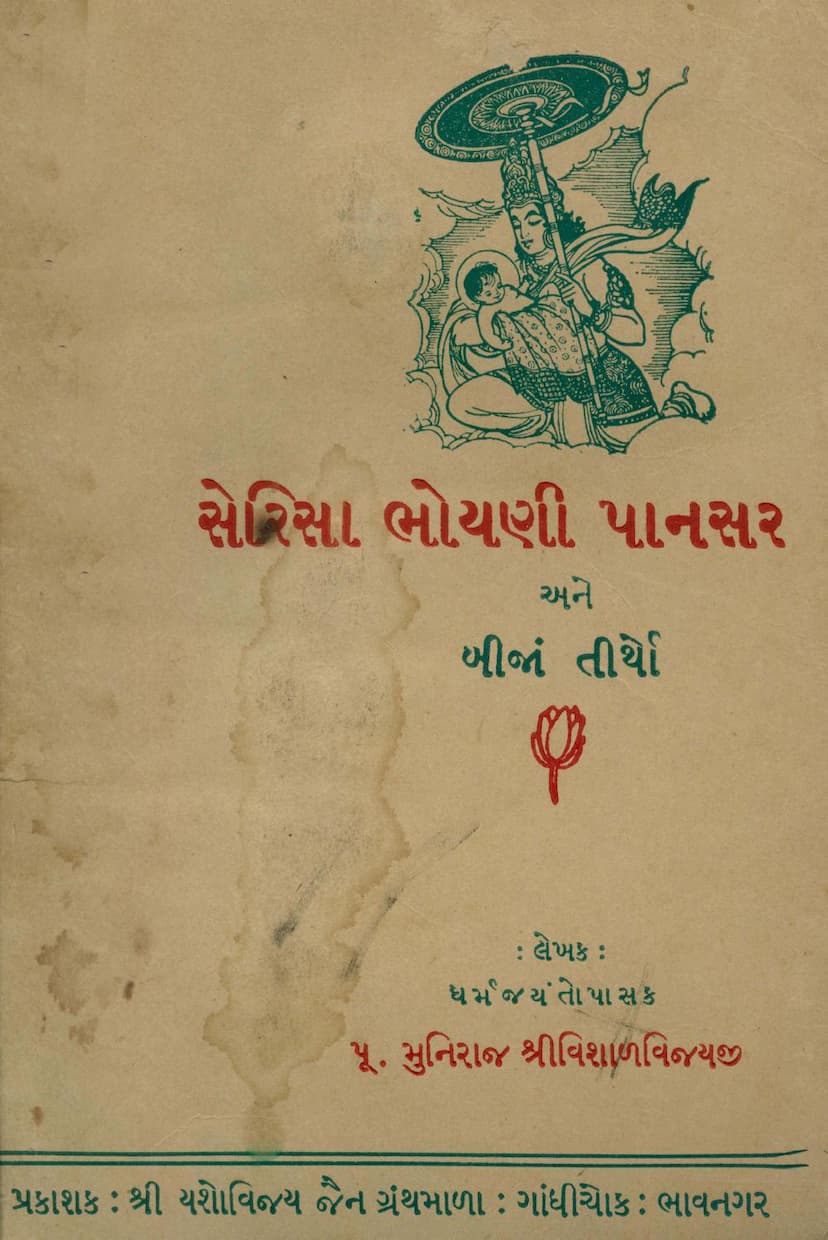Sherisa Bhoyani Pansar Ane Bija Tirtho
Added to library: September 2, 2025

Summary
The book "Sherisa Bhoyani Pansar Ane Bija Tirtho" (સેરિસા ભોયણી પાનસર અને બીજાં તીર્થો) by Muni Vishalvijayji, published by Shri Yashovijay Jain Granthmala, offers a comprehensive guide to several significant Jain pilgrimage sites. The author, Muni Vishalvijayji, despite his ill health and hospitalization, has compiled information about these sacred places, aiming to introduce them to Jain devotees and foster a deeper connection with these holy sites.
The book focuses on six key locations:
-
Sherisa (સેરિસા): This chapter details the ancient and once glorious Jain pilgrimage site of Sherisa, located near Ahmedabad. It delves into its historical rise and fall, mentioning that it was a significant center of Jainism between the 12th and 16th centuries. The text recounts the mythological origin of the site, involving the miraculous arrival of Jain idols through divine intervention and mantras. It also highlights the historical accounts of renowned Jain monks and scholars visiting and writing about Sherisa, emphasizing its spiritual importance and the continued reverence it holds. The chapter includes descriptions of the ancient temple ruins and the subsequent reconstruction of a grander temple.
-
Bhoyani (ભોયણી): This section introduces Bhoyani as a pilgrimage site featuring the idol of Lord Mallinath, the 19th Jain Tirthankar. The narrative describes the miraculous discovery of the idols of Lord Mallinath and two accompanying figures from a well by a farmer. The text recounts the initial disputes between the villagers of Bhoyani and the Jain community of Kukavav regarding the placement of the idols, which were eventually resolved through divine intervention, leading to the idols being enshrined in Bhoyani. The chapter elaborates on numerous miracles attributed to Lord Mallinath at Bhoyani, highlighting its growing significance as a pilgrimage destination. It also details the construction of a grand temple and the facilities available for pilgrims.
-
Pansar (પાનસર): Located near Ahmedabad, Pansar is presented as a Jain pilgrimage site where a beautiful temple of Lord Mahavir Swami is situated. The chapter narrates the discovery of the idol from a farmer's house, which was later confirmed to be a Jain idol. The text describes the construction of a grand temple at Pansar, funded by charitable donations, and the subsequent establishment of Lord Mahavir as the presiding deity. It also mentions ancient idols found in the area, further substantiating the site's historical Jain importance.
-
Vamaj (વામજ): This chapter describes Vamaj as a Jain pilgrimage site located about four miles from Kalel. It recounts the story of a monk who received dreams guiding him to a buried idol of Adinath Bhagwan. The discovery of idols of Adinath, four Kaussargiyas, and celestial attendants is detailed. The text mentions ancient Jain structures and a possible underground passage connecting Vamaj to Sherisa. It also touches upon the reinstallation of idols and the spiritual significance of the site.
-
Upariyala (ઉપરિયાળા): Located about 12 miles west of Viramgam, Upariyala is presented as a Jain pilgrimage site with a temple dedicated to Lord Adinath. The chapter discusses the historical mentions of Upariyala from the 15th century, indicating the presence of an Adinath temple. It details the rediscovery of idols in the 19th century, leading to the construction of a new temple and the establishment of the pilgrimage site. The chapter also highlights the recent renovations and additions made to the temple and its facilities.
-
Vadgam (વડગામ): Situated near Dasada, Vadgam is identified as a Jain pilgrimage site with a temple of Lord Adinath. The chapter narrates the legend of the idol's miraculous discovery in the 12th century, along with a Shiva lingam. It highlights the miraculous powers attributed to the idol, particularly its role in helping the village survive a severe drought. The text also mentions the decline and subsequent revival of the Jain community in Vadgam, along with the renovation of the temple and the surrounding facilities.
The book also includes appendices, such as the "Sherisa Tirthnu Stavan" (શ્રી. સેરિસા તીર્થનું સ્તવન), which provides a devotional hymn dedicated to the deity at Sherisa, and a detailed account of the origin and history of the site. It also features the "Shreyan Mallinathji nu Dhaliyan" (શ્રી. શ્રેયણ મલ્લિનાથજીનાં ઢાળિયાં), a collection of devotional songs related to the temple at Bhoyani.
Overall, "Sherisa Bhoyani Pansar Ane Bija Tirtho" serves as a valuable resource for Jain pilgrims and scholars, offering historical, mythological, and devotional insights into these important Jain holy places. The author's dedication to compiling this information, despite personal challenges, underscores its significance for the Jain community.